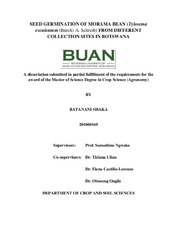| dc.description.abstract | Understanding the seed biology and germination ecology of plants is critical for bringing them into cultivation, yet this information is insufficient for Tylosema esculentum despite its potential as a future crop. T. esculentum (Morama bean) is a multi-use, drought-tolerant legume highly valued by local communities. It is adapted to arid regions in Botswana, Namibia and South Africa, where it is traditionally wild harvested for its natural and economic value. Tylosema esculentum belongs to the family Fabaceae and is found growing in many parts of Botswana, Namibia and South Africa. Seeds for this study were collected from Charleshill, Malwelwe, Malatswai and Kerebotse Farm in Botswana. The experiment was conducted in the laboratory at Royal Botanic Gardens, Kew in the Wellcome Trust Millennium Building, Wakehurst Place, Ardingly, United Kingdom. The main objective of the study is to evaluate seed germination of Tylosema esculentum from different collection sites. The study determined the temperature thresholds of the different collection sites for seed germination, rate of imbibition between scarified seeds and nonscarified seeds. Further to this, the study focused on the effect of light at 25oC for all the collection sites and comparing the seed moisture content, weight and morphology of seeds of T. esculentum between the collection sites. The seed germination results show that the highest germination rate is between 25oC and 35oC for all the collection sites. There was a significant difference in the optimum temperature (To) in the cardinal temperatures while there was no difference in minimum (or base, Tb) and maximum (or ceiling Tc) temperatures for the collection sites. For the thermal time there was no significant difference in both the sub-optimal and supra-optimal range of temperatures between the collection sites. The imbibition rate for all the collection sites showed that there was higher water intake for scarified seeds as compared to non-scarified seeds. There was no xv difference in germination rate and germination percentage between light and dark treatments as the results showed that they were high for all the collection sites. The morphology of seeds showed that there was no significant difference between the collection sites, whereas weight and moisture content showed a significant difference among the collection sites. | en_US |

